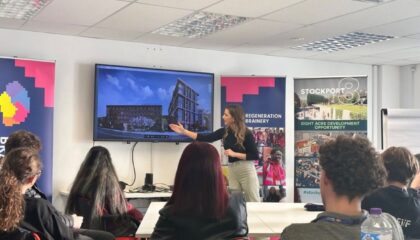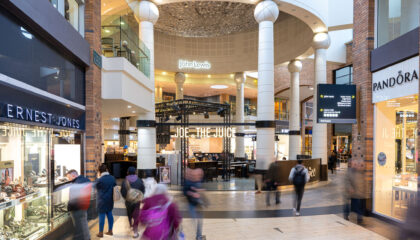Building the social value of an urban garden (even during a pandemic)
Despite the challenges of the past year, the Workman team at Central Retail Park, Falkirk, created an urban garden to promote biodiversity and community links in the neighbourhood. Not only has the garden blossomed, producing flowers, fruit and veg, it has also provided solace and a source of mental wellbeing for both the Workman team and occupier staff, during the bleak and often lonely months of lockdown.
Having provided a beacon of hope to the local area, the garden has now been honoured with a GOLD Scottish Green Apple Award for Environmental Best Practice 2021 to recognise, reward and promote environmental best practice.
Central Retail Park in Falkirk is built on an old ironworks, and as such, most of its ground is reinforced concrete, so ground planting isn’t viable. But with creative thinking and determination, the Workman team made the project a triumph. They began by identifying two unused areas in a service yard, which were perfect for creating green spaces to encourage wildlife. One space was turned into a wildflower meadow, requiring only scattering of seeds, while the other space is already walled off on three sides, thus providing a sheltered location, ideal for a garden. However, the team knew that all planting would need to be in raised beds, due to the shallow ground.
Galvanise teams through garden creation
Here, the team spotted an opportunity: the retail park is host to 31 retail occupiers needing to dispose of non-returnable pallets, made of wood that’s pre-treated for outdoor use. So, in the spirit of the circular economy, simple designs were used to construct planters, and also fencing for the area. Old display furniture was donated by occupiers, fly-tipped items such as old tyres and bins were repurposed as useful planters, while all by-products of the site’s landscaping contractor is used for compost, so waste is reduced.
Planters were lined and filled with compost ready for growing, and coffee grounds were collected from occupiers for soil enrichment. And although the work has taken time, it has been completed at a fraction of the cost of buying new materials. A composting area, rainwater collection system and workbench have also been created, while unsold perennial plants donated by occupiers were replanted in the garden and have now been used as a source of seeds for propagation for 2021’s hanging baskets.
The Workman team, along with people from site contractor firms who were keen to get involved, spent time after their shifts, or even while furloughed, to create – and then help maintain – the garden. The engagement and interest level in the building of the garden has been rewarding and has brought local teams closer together, galvanising them through difficult times. One member of the security staff felt so moved by the garden’s impact on his mental wellbeing during lockdown that he wrote a letter of thanks to the Workman team. This letter hit home with the whole team, demonstrating the positive impact this project has had on the well-being of everyone involved. This benefit was not something that was envisaged at the start of the project; but is perhaps its most satisfying impact.
Lay the groundwork to spring into life
Not only is the garden productive and a boost to biodiversity, it also provides a safe, quiet outdoor space for use as a lunch or breakout space throughout the day. It has made the Workman team and occupiers realise that however small or hostile a space may seem, everyone can do something to help increase biodiversity, bring social engagement and community value.
Due to the restrictions of lockdown, the team’s plans to involve local community groups and schools had to be paused. However, community links have been put in place, and as the world begins to open up, preparations have been made for local schools to take ownership of sections of the community garden, which they will use as part of their outdoor learning and eco-skills lessons. Plans are also afoot for garden-themed children’s summer storytelling events, plus a pumpkin patch, for which last year’s seeds have already been propagated. This will provide the opportunity for pumpkin picking and carving events around Halloween, attracting people to the garden and the retail park itself.
Broader social plans include community gardening and ‘how to’ workshops to teach upcycling skills, forging links with local groups, developing a growing schedule, tracking the increase of bug and birdlife, and creating social media content on wildlife and garden projects.
Forge lasting local community links
By achieving social value within the community, it is hoped that the Falkirk garden will in turn encourage others in the local area to create a natural space in otherwise brownfield sites. It’s about encouraging local wildlife and getting people interested in gardens where they weren’t necessarily before. This has already caught the imagination of groups of occupier staff who would like to explore using additional space near their unit for similar projects.
The end goal is to make the Falkirk garden as sustainable as possible, by propagating plants from seed, and involving occupiers and local community groups to manage and enjoy their own sections.
Even amid the chaos and unpredictability caused by Covid-19 and lockdowns, the Falkirk team has maximised an opportunity to create a unique garden. And as lockdowns ease and the world returns to normality, the park will benefit from the groundwork laid, enabling it to spring into life.
By David McKay, Senior Associate, Workman Retail & Leisure
Five ways to replicate the SOCIAL success of the Falkirk urban garden:
- It’s often possible to create bug, bird and hedgehog homes completely from natural or waste materials either donated by occupiers or from discarded pallets, bricks, wood and hay, for example. This means materials that would otherwise have been collected for waste get recycled to provide a safe and sheltered habitat for wildlife, increasing the biodiversity in the area while reducing waste costs. Local schools are often keen to get involved in making bird and bug houses, as well as tracking their use.
- Consider the use of wildlife cameras, which allow images to be filmed of animals using the areas and helps identify types of animals living in and around the site. This footage is not only key to determining the urban biodiversity achieved, it also forms engaging content for local community groups and schools making site visits.
- Where there are no beds or borders (and no opportunity to create them) consider making raised planters. With some DIY skills, these can be made from recycled materials such as discarded pallets, and can be used to create gardens in the most limited of spaces – outside reception areas or to create natural barriers in car parks – even where there is only concrete space.
- Run community workshops to allow people to learn a new skill, meet new people and become more engaged with the site. At Falkirk, workshops are planned through the development of the garden to include building projects, planting and growing, garden development, community activities, storytelling and team building.
- To ensure continued interest and sustainability, invite occupier staff, community and school groups to take part in activities, or to take ownership of a planter, or section of garden, to design, grow and maintain.



